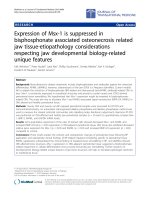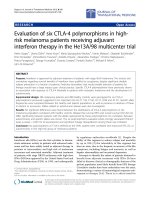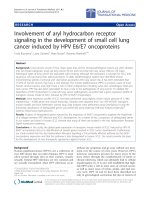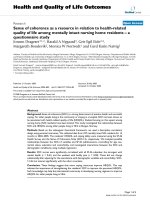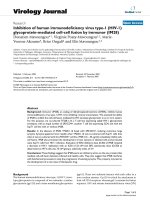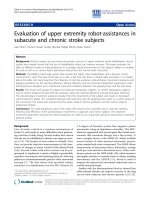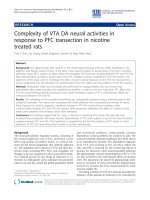Báo cáo hóa học: " Inhibition of foot-and-mouth disease virus replication in vitro and in vivo by small interfering RNA" pot
Bạn đang xem bản rút gọn của tài liệu. Xem và tải ngay bản đầy đủ của tài liệu tại đây (487.86 KB, 6 trang )
BioMed Central
Page 1 of 6
(page number not for citation purposes)
Virology Journal
Open Access
Short report
Inhibition of foot-and-mouth disease virus replication in vitro and in
vivo by small interfering RNA
Wang Pengyan, Ren Yan, Guo Zhiru* and Chen Chuangfu*
Address: College of Animal Science and Technology, Shihezi University, Shihezi, Xinjiang, 832003, PR China
Email: Wang Pengyan - ; Ren Yan - ; Guo Zhiru* - ; Chen Chuangfu* - ccf-
* Corresponding authors
Abstract
By using bioinformatics computer programs, all foot-and-mouth disease virus (FMDV) genome
sequences in public-domain databases were analyzed. Based on the results of homology analysis, 2
specific small interfering RNA (siRNA) targeting homogenous 3D and 2B1 regions of 7 serotypes
of FMDV were prepared and 2 siRNA-expression vectors, pSi-FMD2 and pSi-FMD3, were
constructed. The siRNA-expressing vectors were used to test the ability of siRNAs to inhibit virus
replication in baby hamster kidney (BHK-21) cells and suckling mice, a commonly used small animal
model. The results demonstrated that transfection of BHK-21 cells with siRNA-expressing
plasmids significantly weakened the cytopathic effect (CPE). Moreover, BHK-21 cells transiently
transfected with short hairpin RNA (shRNA)-expressing plasmids were specifically resistant to the
infection of the FMDV serotypes A, O, and Asia I and this the antiviral effects persisted for almost
48 hours. We measured the viral titers, the 50% tissue culture infective dose (TCID
50
) in cells
transfected with anti-FMDV siRNAs was found to be lower than that of the control cells.
Furthermore, subcutaneous injection of siRNA-expressing plasmids in the neck of the suckling mice
made them less susceptible to infection with O, and Asia I serotypes of FMDV.
Findings
Foot-and-mouth disease (FMD) is an acute and highly
contagious disease requiring expensive treatment occur-
ring in cloven-hoofed animals. The etiological agent of
FMD is foot-and-mouth disease virus (FMDV), which
belongs to the genus Aphthovirus of the family Picornaviri-
dae [1]. The spreading capacity of the virus and its ability
to change its antigenic identity make it a serious threat to
the beef and dairy industries in many countries. FMDV
has 7 serotypes and over 70 subtypes. Owing to the
absence of reciprocal protection among all the serotypes,
it is difficult to control FMD through vaccination and
impossible to eliminate FMD by conservative natural
breeding. A recent occurrence of a large epidemiogenesis
has made the development of emergency antiviral strate-
gies essential for preventing outbreaks of FMD.
RNA interference (RNAi) is a process of sequence-specific,
posttranscriptional gene silencing (PTGS) in animals and
plants, which can be induced by 21- to 23-nucleotide (nt)
siRNA that demonstrates sequence homology to the target
gene [2,3]. It is well known that one obvious potential
function for the RNAi machinery would be to defend cells
against viruses that express dsRNA as part of their life cycle
[4]. Indeed, there is compelling evidence indicating that
RNAi is critical incurtailing viral infections in both plants
and invertebrates. Moreover, it can be readily demon-
strated that the artificial induction of an antiviral RNAi
Published: 25 July 2008
Virology Journal 2008, 5:86 doi:10.1186/1743-422X-5-86
Received: 23 April 2008
Accepted: 25 July 2008
This article is available from: />© 2008 Pengyan et al; licensee BioMed Central Ltd.
This is an Open Access article distributed under the terms of the Creative Commons Attribution License ( />),
which permits unrestricted use, distribution, and reproduction in any medium, provided the original work is properly cited.
Virology Journal 2008, 5:86 />Page 2 of 6
(page number not for citation purposes)
response in mammalian cells can confer strong protection
against a wide range of pathogenic viruses [5]. Neverthe-
less, it remains unclear whether RNAi is involved in anti-
viral defense in mammalian cells in physiological
conditions. Mammalian cells were originally thought to
be unlikely to posses an active RNA-silencing machinery
[6], besides a nonspecific, interferon mediated antiviral
response mediated by dsRNA [7,8], especially by viral
long (35-nt) dsRNA [9]. The recent description of RNAi in
mammalian cells proved that the RNA silencing machin-
ery is conserved in mammals [10]. In some cases, a strong
antiviral effect of RNAi was observed in the cases of
human immunodeficiency virus [11,12], hepatitis B virus
[13,14] and poliovirus and human papillomavirus
[15,16]. In fact, several viruses have now been shown
either to express their own miRNAs in infected cells or to
take advantage of host cell miRNAs to enhance their rep-
lication [17-19]. It therefore seems reasonable to propose
that the extremely potent interferon system has displaced
RNAi as the key defense against virus infection in mam-
malian cells [20]. SiRNA probably operates at multiple
levels in mammals, its main action is expected to be medi-
ated at the posttranscriptional level by rapid destruction
of homologous mRNAs. The use of siRNA as an antiviral
agent could lead to a selective pressure on the siRNA target
sequences that might result in the appearance of escape
variants due to the changes in the target sequence. Thus,
the selected virus target sequences were located in the con-
served regions of the virus genome [21]. In this study, we
describe the use of RNAi in inhibiting virus replication in
BHK-21 cells and suckling mice. The selected siRNA tar-
gets had 100% identity when compared with all the
FMDV sequences deposited in GenBank, regardless of
their serotype. This level of identity is an indication of a
strong selective pressure against mutations since this
sequence resists changes during the evolution of the virus.
This selective pressure could maintain the siRNA target
sequences without alterations, ensuring the effective activ-
ity of the siRNAs described in the present study. This work
offers an insight into the use of RNAi in animal breeding
for disease resistance.
The commercial plasmid pSilencer5. 1-H1 was used to
express the inverted-repeat RNA corresponding to homog-
enous 3D and 2B1 coding regions of the 7 serotypes of
FMDV. 2 siRNAs template primers were
FMDV-2
(p1): 5'-
GATCCGCTACAGATCACCATACCTTTCAAGAGAAGG-
TATGGTGATCTGTAGCTTTTTTGGAAA-3'(p2): 5'-
AGCTTTTCCAAAAAAGCTACAGATCACCATACCT-
TCTCTTGAA AGGTATGGTGATCTGTAGCG-3'
FMDV-3
(p1): 5'-
GATCCGCCAGATGCAGAGGGACATGTTCAAGAGACAT-
GTCCCTCTGCATCTGGTTTTTTGGAAA-3'
(p2): 5'-
AGCTTTTCCAAAAAACCAGATGCAGAGGGACAT-
GTCTCTTGAACATGTCCCTCTGCATCTGGCG-3'
First, The 2 pairs of primers were annealed and ligated
with the linear retrovirus vector pSilencer5. 1-H1 to pro-
duce 2 siRNA-expression vectors – pSi-FMD2 and pSi-
FMD3. Sequencing confirmed the correct ligation of the
two plasmids. The primer used for sequencing was: 5'-
TTGTACACCCTAAG CCTCCG-3'.
We determined first whether transient siRNAs expression
could trigger an antiviral response on BHK-21 cell infected
with FMDV. Transient cellular transfection and identifica-
tion of FMDV were conducted in BHK-21 cells. Twenty
four hours post-transfection, the transfected cells were
infected with 5 × 10
3
TCID
50
/cell of FMDV serotypes A, O,
and Asia1. The CPEs of the BHK-21 cells were observed at
10, 12, 18, 24, 36 and 48 h postinfection. Samples of
supernatant were obtained at designated time points, and
the TCID
50
were determined by the Reed-Muench for-
mula. BHK-21 cells are fibroblastic, growing in a monol-
ayer, and having a well-defined tendency for parallel
orientation. Viral infection causes a marked CPE resulting
in total cellular detachment, rounding, and destruction,
which can be observed under a microscope. As shown in
Fig. 1, CPEs appeared in the BHK-21 cells infected with
FMDV serotype A at 12 h postinfection and were particu-
larly severe among the 4 groups between 24 h to 36 h. Cel-
lular detachment, rounding, and destruction of the
control group were more severe than the experimental
group. At 48 h postinfection, the cells of the control group
were dead and almost detached. CPEs appeared in the
BHK-21 cells infected with FMDV serotype O and Asia I at
6–8 h postinfection and were particularly severe at 10–12
h postinfection. To further substantiate the antiviral activ-
ity, we determined the virus yield of cells infected with the
3 viruses at designated time points. The TCID
50
of the
FMDV serotypes A, O, and Asia I detected in supernatants
collected from cells transfected with FMDV-specific
siRNA-expressing plasmids was lower than that in the
control cells.(Fig. 2) However, no significant inhibition
was observed after 48 h (FMDV serotype A) and 18 h
(FMDV serotypes O and Asia I). These results suggest that
transient expression of FMDV hairpin RNA is competent
to trigger an antiviral response on BHK-21 cell.
To further test the anti-FMDV activity of the siRNAs, we
challenged Kunming White suckling mice (2–3 days old
and weighing 3–4 g). The suckling mice were subcutane-
Virology Journal 2008, 5:86 />Page 3 of 6
(page number not for citation purposes)
CPEs of BHK-21 cells infected with FMDV at different timesFigure 1
CPEs of BHK-21 cells infected with FMDV at different times. A. CPEs of BHK-21 cells transfected with FMDV-specific
siRNA-expressing plasmid;. B. CPEs of BHK-21 cells transfected with control plasmid;. C. CPEs of Control BHK-21 cells. As
showed in Fig. 1, CPEs appeared in the BHK-21 cells infected with FMDV serotype A at 12 h postinfection and were particu-
larly severe among the 4 groups between 24 h to 36 h. Cellular detachment, rounding, and destruction of the control group
were more severe than the experimental group. At 48 h postinfection, the cells of the control group were dead and almost
detached.
12h 24h 36h 48h
A
B
C
Virology Journal 2008, 5:86 />Page 4 of 6
(page number not for citation purposes)
TCID
50
of the FMDV serotypes A, O, and Asia I at different timesFigure 2
TCID
50
of the FMDV serotypes A, O, and Asia I at different times. (A): TCID
50
of FMDV A at different times. (B):
TCID
50
of FMDV O at different times. (C): TCID
50
of FMDV AsiaI at different times. The TCID
50
of the FMDV serotypes A, O,
and Asia I detected in supernatants collected from cells transfected with FMDV-specific siRNA-expressing plasmids was lower
than that in the control cells.
(A) TCID
50
of FMDV A at different times
0
1
2
3
4
5
6
7
pSi-FMD2 pSi-FMD3 Negative
control
Blank control
TCID
50
/0.1ml
12h
18h
24h
36h
48h
(B) TCID
50
of FM DV O at different times
pSi-FMD2 pSi-FMD3 Negative
control
Blank control
TCID
50
/0.1ml
1h
10h
18h
(C) TCID
50
of FM DV AsiaI at different times
0
1
2
3
4
5
6
pSi-FMD2 pSi-FMD3 Negative
control
Blank control
TCID
50
/0.1ml
1h
10h
18h
Virology Journal 2008, 5:86 />Page 5 of 6
(page number not for citation purposes)
ously injected in the neck with 50–100 ug of plasmids dis-
solved in 100 ul of saline. Mice of the control group were
subcutaneously injected with saline. After 6 h, the suck-
ling mice were challenged with 5 and 20 LD
50
of the
FMDV serotypes O, and Asia I per 0.1 milliliter by subcu-
taneous injection in the neck near the site that received the
injected DNA and were then observed for 5–6 days
postchallenge. All saline-injected mice (n _ 10 mice per
group) died within 69 h, with most mice dying within 48
h, after the viral challenge. Only 3 of 9–10 mice pretreated
with pSi-FMD2 and 4 of 10 mice pretreated with pSi-
FMD3, survived a viral challenge of 5 LD
50
for 5 days of
observation. Further, only 1 of 9 mice pretreated with pSi-
FMD2 and 1 of 9–10 mice pretreated with pSi-FMD3 sur-
vived a viral challenge of 20 LD
50
for 5 days of observa-
tion. The percentage survival is shown in tables 1 and
tables 2. Thus, table 1 and tables 2 clearly indicate that the
mice treated with siRNA-expressing plasmids had reduced
susceptibility to virus infection.
In this work, it was demonstrated that transfection of
BHK-21 cells with the 2 siRNA-expressing plasmids could
induce a lower CPE compared with the controls. Further,
the TCID
50
of the FMDV serotypes A, O, and Asia I
detected in supernatants collected from cells transfected
with FMDV-specific siRNA-expressing plasmids was lower
than that of control cells. On the other hand, expression
of a 21-nt siRNA heterologous to the FMDV genome did
not significantly reduce virus replication. In addition,
when challenged by 5 LD
50
or 20 LD
50
of the FMDV sero-
types O, or Asia I after injecting FMDV-specific siRNA-
expressing plasmids, 10–40% suckling mice could resist
virus infection. This report, as well as the results of others
[22,23] suggests that double-stranded RNA (dsRNA) is a
very powerful tool for the inhibition of virus replication
and has a high therapeutic potential. In our case, the inhi-
bition effect is not so well-defined as in the result reported
by Chen et al [24] and Ronen Kahana et al [25]. However,
in this study, siRNAs targeting 2 highly conserved
sequences that could inhibit 3 viral serotypes were
designed. Further research is required to determine
whether this is the case for the other serotypes also.
Competing interests
The authors declare that they have no competing interests.
Authors' contributions
CCF, GZR Design and conception of study, WPY Plasmids
constructs and inhibition analysis, WPY manuscript prep-
aration. RY Breeding of mouse. All authors read and
approved the final manuscript.
Acknowledgements
We thank Jiong Huang, Yuhong Wang and Ying Xue for their assistance.
This work was supported by a grant from the Bingtuan Doctor Foundation
Program (05JC04, XinJiang, China).
References
1. Pereira HG: Foot-and-mouth disease. In Virus diseases of food ani-
mals Edited by: Gibbs EPJ. Academic Press, San Diego, Calif;
1981:333-363.
2. Waterhouse PM, Wang MB, Lough T: Gene silencing as an adap-
tive defense against viruses. Nature 2001, 411:834-842.
3. Zamore PD, Tuschl T, Sharp PA, Bartel DP: RNAi: double-
stranded RNA directs the ATP-dependent cleavage of
mRNA at 21 to 23 nucleotide intervals. Cell 2000, 101:25-33.
4. Vance V, Vaucheret H: RNA silencing in plants-defense and
counter-defense. Science 2001, 292:2277-2280.
5. Gitlin L, Andino R: Nucleic acid-based immune system: the
antiviral potential of mammalian RNA silencing. J Virol 2003,
77:7159-7165.
6. Fire A: RNA-triggered gene silencing. Trends Genet 1999,
15:358-363.
7. Leib DA, Machalek MA, Williams BR, Silverman RH, Virgin HW: Spe-
cific phenotypic restoration of an attenuated virus by knock-
out of a host resistance gene. Proc Natl Acad Sci USA 2000,
97:6097-6101.
8. Stark GR, Kerr IM, Williams BR, Silverman RH, Schreiber RD: How
cells respond to interferons. Annu Rev Biochem 1998, 67:227-264.
9. Cullen BR: RNA interference: antiviral defense and genetic
tool. Nat Immunol 2002, 3:597-599.
Table 1: The survival of mice challenged by FMDV AsiaI
saline FMD2 survival FMD3 survival
5LD
50
died within 69 h 3/9 33.3% 4/10 40%
20LD
50
died within 69 h 1/9 11.1% 1/9 11.1%
The suckling mice were subcutaneously injected in the neck with 50–
100 ug of plasmids dissolved in 100 ul of saline. After 6 h, the suckling
mice were challenged with 5 LD
50
and 20 LD
50
FMDV serotypes Asia I
per 0.1 milliliter by subcutaneous injection in the neck near the site
that received the injected DNA and were then observed for 5–6 days
postchallenge. All saline-injected mice (n _ 10 mice per group) died
within 69 h, with most mice dying within 48 h, after the viral
challenge. Only 3 of 9 mice pretreated with pSi-FMD2 and 4 of 10
mice pretreated with pSi-FMD3, survived a viral challenge of 5 LD
50
for 5 days of observation. Further, only 1 of 9 mice pretreated with
pSi-FMD2 and 1 of 9 mice pretreated with pSi-FMD3 survived a viral
challenge of 20 LD
50
for 5 days of observation.
Table 2: The survival of mice challenged by FMDV O
saline FMD2 survival FMD3 survival
5LD
50
died within 69 h 3/10 30% 4/10 40%
20LD
50
died within 69 h 1/10 10% 1/10 10%
The suckling mice were subcutaneously injected in the neck with 50–
100 ug of plasmids dissolved in 100 ul of saline. After 6 h, the suckling
mice were challenged with 5 LD
50
and 20 LD
50
FMDV serotypes 0 per
0.1 milliliter by subcutaneous injection in the neck near the site that
received the injected DNA and were then observed for 5–6 days
postchallenge. All saline-injected mice (n _ 10 mice per group) died
within 69 h, with most mice dying within 48 h, after the viral
challenge. Only 3 of 10 mice pretreated with pSi-FMD2 and 4 of 10
mice pretreated with pSi-FMD3, survived a viral challenge of 5 LD
50
for 5 days of observation. Further, only 1 of 10 mice pretreated with
pSi-FMD2 and 1 of 10 mice pretreated with pSi-FMD3 survived a viral
challenge of 20 LD
50
for 5 days of observation.
Publish with BioMed Central and every
scientist can read your work free of charge
"BioMed Central will be the most significant development for
disseminating the results of biomedical researc h in our lifetime."
Sir Paul Nurse, Cancer Research UK
Your research papers will be:
available free of charge to the entire biomedical community
peer reviewed and published immediately upon acceptance
cited in PubMed and archived on PubMed Central
yours — you keep the copyright
Submit your manuscript here:
/>BioMedcentral
Virology Journal 2008, 5:86 />Page 6 of 6
(page number not for citation purposes)
10. Elbashir SM, Harborth J, Lendeckel W, Yalcin A, Weber K, Tuschl T:
Duplexes of 21-nucleotide RNAs mediate RNA interference
in cultured mammalian cells. Nature 2001, 411:494-498.
11. Lee NS, Dohjima T, Bauer G, Li H, Li MJ, Ehsani A, Salvaterra P, Rossi
J: Expression of small interfering RNAs targeted against HIV-
1 rev transcripts in human cells. Nat Biotechnol 2002,
20:500-505.
12. Novina CD, Murray MF, Dykxhoorn DM, Beresford PJ, Riess J, Lee
SK, Collman RG, Lieberman J, Shankar P, Sharp PA: siRNA-directed
inhibition of HIV-1 infection. Nat Med 2002, 8:681-686.
13. Shlomai A, Shaul Y: Inhibition of hepatitis B virus expression
and replication by RNA interference. Hepatology 2003,
37:764-770.
14. Song E, Lee SK, Wang J, Ince N, Ouyang N, Min J, Chen J, Shankar P,
Lieberman J: RNA interference targeting Fas protects mice
from fulminant hepatitis. Nat Med 2003, 9:347-351.
15. Gitlin L, Karelsky S, Andino R: Short interfering RNA confers
intracellular antiviral immunity in human cells. Nature 2002,
418:430-434.
16. Jiang M, Milner J: Selective silencing of viral gene expression in
HPV-positive human cervical carcinoma cells treated with
siRNA, a primer of RNA interference. Oncogene 2002,
21:6041-6048.
17. Pfeffer S, Sewer A, Lagos-Quintana M, Sheridan R, Sander C, Grasser
FA, van Dyk LF, Ho CK, Shuman S, Chier M, Russo JJ, Ju J, Randall G,
Lindenbach BD, Rice CM, Simon V, Zavolan M, Tuschl T: Identifica-
tion of microRNAs of the herpesvirus family. Nat Methods
2005, 2:269-276.
18. Sullivan CS, Grundhoff AT, Tevethia S, Pipas JM, Ganem D: SV40-
encoded microRNAs regulate viral gene expression and
reduce susceptibility to cytotoxic T cells. Nature 2005,
435:682-686.
19. Cullen BR: RNAi the natural way. Nat Genet 2005, 37:1163-1165.
20. Katze MG, He Y, Gale M Jr: Viruses and interferon: a fight for
supremacy.
Nat Rev Immunol 2002, 2:675-687.
21. Stram Y, Molad T: A ribozyme targeted to cleave the polymer-
ase gene sequences of different foot-and-mouth disease virus
(FMDV) serotypes. Virus Genes 1997, 15:33-37.
22. Park W-S, Miyano-Kurosaki N, Hayafune M, Nakajima E, Matsuzaki T,
Shimada F, Takaku H: Prevention of HIV-1 infection in human
peripheral blood mononuclear cells by specific RNA interfer-
ence. Nucleic Acids Res 2002, 30:4830-4835.
23. Capodici J, Kariko K, Weissman D: Inhibition of HIV-1 infection
by small interfering RNA-mediated RNA interference. J
Immunol 2002, 169:5196-5201.
24. Chen W, Yan W, Du Q, Fei Li, Niu M, Ni Z, Sheng Z, Zheng Z: RNA
Interference Targeting VP1 Inhibits Foot-and-Mouth Dis-
ease Virus Replication in BHK-21 Cells and Suckling Mice.
Journal of Virology 2004, 78:6900-6907.
25. Kahana Ronen 1, Kuznetzova Larisa 1, Rogel Arie, et al.: Inhibition
of foot-and-mouth disease virus replication by small interfer-
ing RNA. Journal of General Virology 2004, 85:3213-3217.


